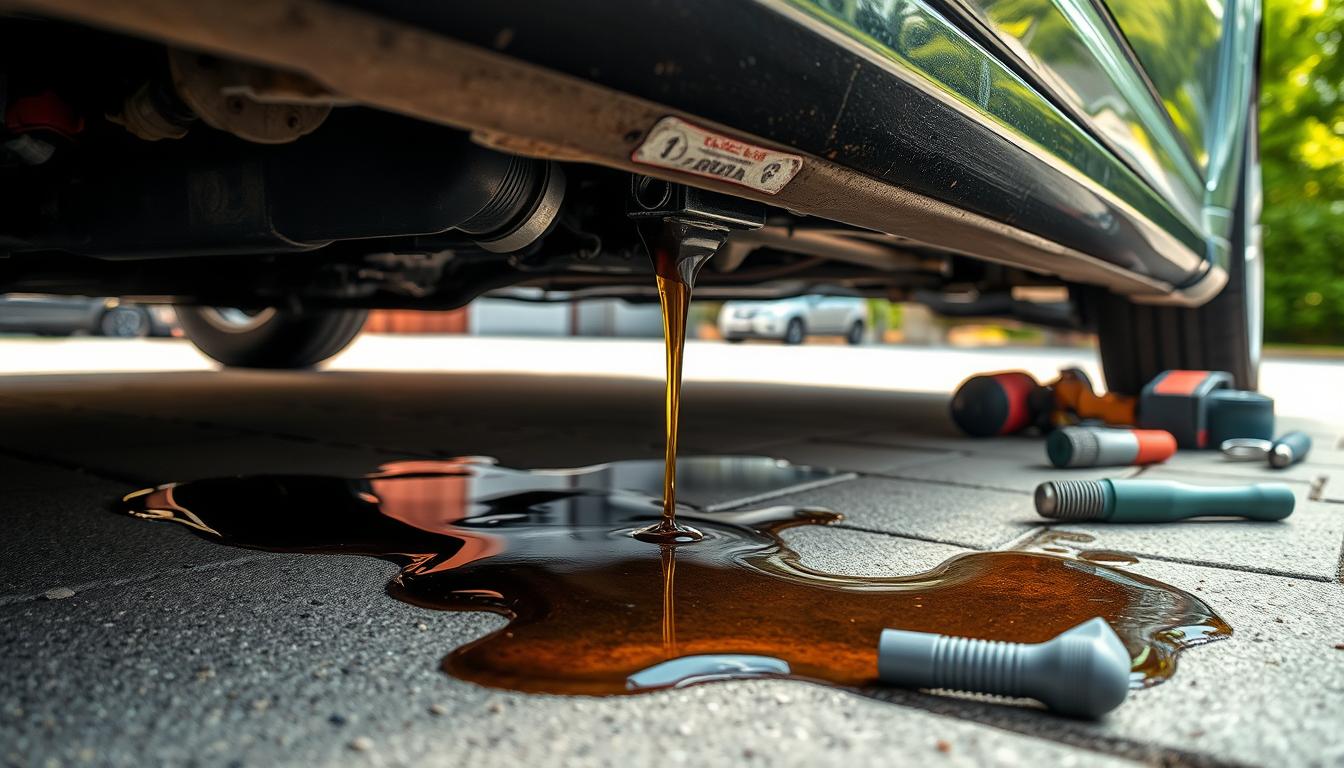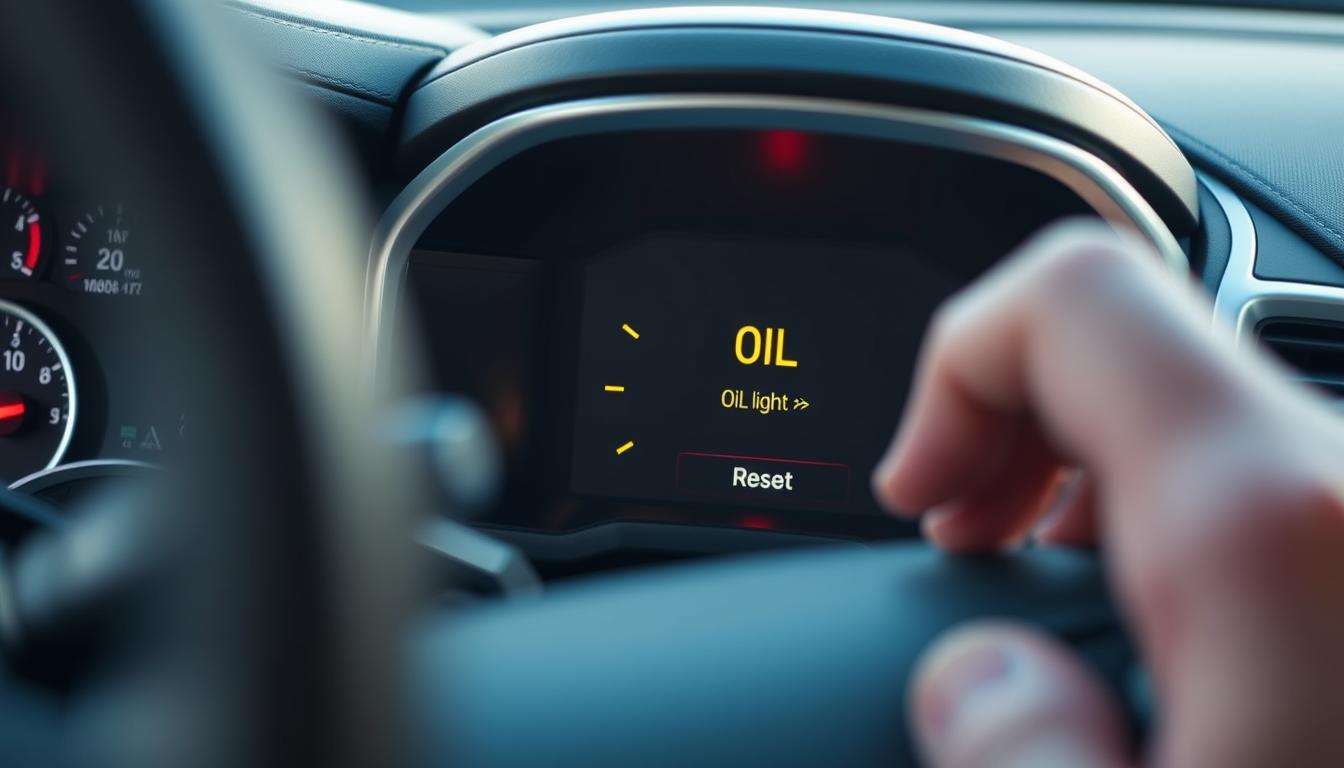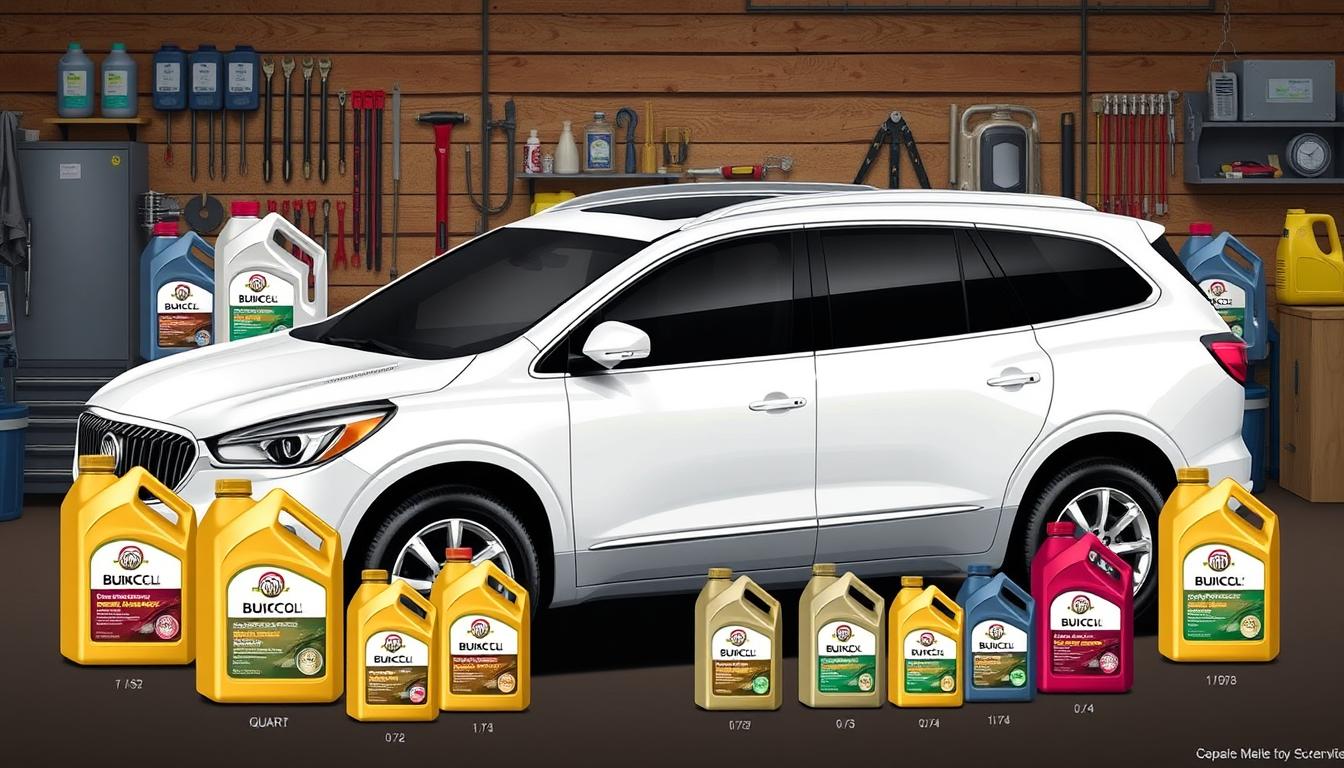Ever found a puddle of oil under your parked car? It’s a worry, especially right after an oil change. Your car isn’t just a way to get around. It’s a dependable friend for work, family, and adventure. Oil is key to keep it going smoothly. But finding a leak can be unsettling. After all, an oil change should make things better, not worse. This article will cover why oil leaks happen, how to spot them, and how to fix them. We want your vehicle to remain a joy, not a source of stress.
Key Takeaways
- Oil is critical for the performance and longevity of your vehicle.
- Common causes of oil leaks post oil change include double filter gaskets and improper drain plug installation.
- Identifying the symptoms of oil leaks early can prevent more severe engine issues.
- Regular maintenance and timely oil changes are key in avoiding future leaks.
- Temporary products can help but seeking professional help for persistent leaks is essential.
Understanding the Importance of Engine Oil
Engine oil is key to your vehicle’s smooth operation. It mainly works by lubricating the moving parts. This action cuts down friction and helps in keeping the engine at the right temperature. Engine oil significance is thus central to your engine’s long life. Without the right oil levels and frequent changes, parts may wear out fast. This affects the engine performance and its efficiency.
Keeping up with oil maintenance is crucial for your car’s performance. Besides lubrication, oil also removes harmful contaminants. As oil moves through the engine, it picks up dirt and debris. This keeps the oil clean and effective. Ignoring this process can cause big problems. These include damage to important parts, which could lead to expensive repairs.
Addressing oil leaks or issues quickly is important. Even a tiny leak can grow, causing loss of pressure and more wear due to poor lubrication. Over time, this might cause metal parts to rub directly against each other. This creates more engine problems. Thus, managing oil maintenance well is key to your engine’s health. It’s important to stick to regular oil changes and checks.
| Aspect | Importance |
|---|---|
| Lubrication | Reduces friction and wear on engine components |
| Temperature Regulation | Prevents overheating through efficient heat exchange |
| Contaminant Removal | Filters out dirt and debris to maintain oil purity |
| Engine Efficiency | Ensures optimal performance through proper lubrication |
| Longevity | Extends the life of the engine by preventing wear |
What Causes Oil Leaks in Vehicles?
Oil leaks are a headache for vehicle owners. Knowing why they happen helps with upkeep. Often, common oil leak sources include worn-out seals and gaskets. These parts include the valve cover, cylinder head, timing cover, and oil pan gaskets. They wear down and may allow oil to escape.
The oil filter also plays a big part. If not installed right during oil changes, leaks can occur. It’s important to check your car after maintenance to catch any problems early. Also, a damaged oil plug or cap can cause leaks if they’re not sealing properly.
Leaking camshaft seals in engines with timing belts can cause oil to pool under the car. This might also lead to smoke coming from the engine. Putting too much oil can pressure the system and cause leaks.
To avoid engine oil leaks, keeping up with car maintenance is key. Some engine oils can help old gaskets and seals work better, especially in cars with many miles. A visit to a service center, like Tires Plus, can check your engine oil. This could greatly lower your chances of having leaks.
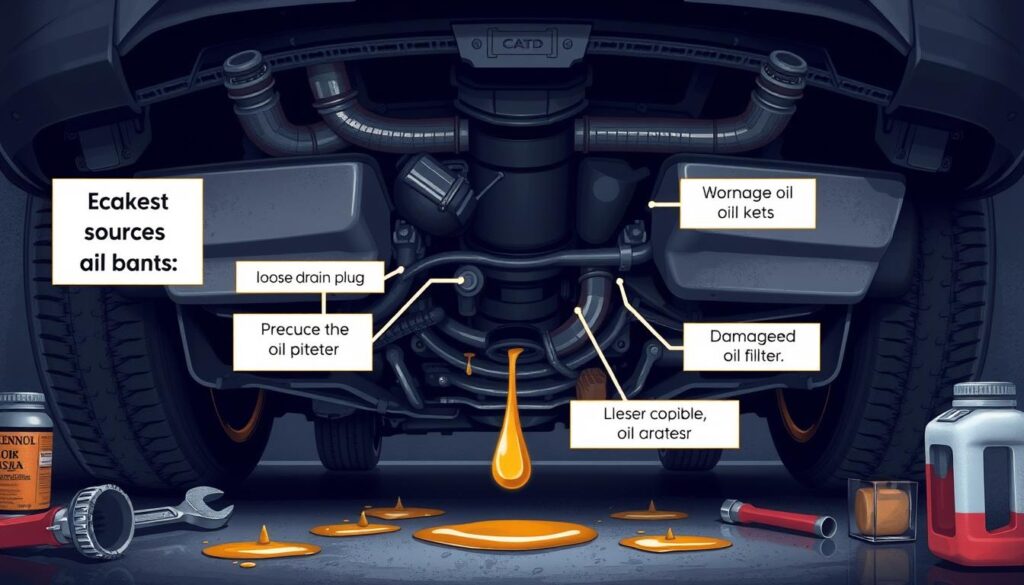
Common Reasons for Car Leaking Oil After Oil Change (Causes and Fixes)
Finding oil leaks after an oil change can be annoying. Knowing the main reasons helps deal with them. Look into issues like double filter gaskets, mistakes in installation, and drain plug problems.
Double Filter Gaskets
Oil leaks often start with double filter gaskets. This happens if the old gasket doesn’t get taken off when you put on a new oil filter. It causes a bad seal. To fix it, make sure to remove the old gasket first. Then, put on the new filter with its own gasket the right way. Doing regular checks can prevent such problems.
Bad Filter Installation
Putting in the oil filter wrong is a usual leak cause. If you don’t tighten it enough, it might not seal well. But, tighten it too much, and you could harm the threads. This might lead to big problems later. Hand-tightening then giving a quarter turn with a wrench is the best method. Make sure the filter fits your car model. This stops future problems and keeps your car running smooth.
Drain Plug Issues
Drain plug troubles can also cause leaks. Often, a loose drain plug comes from taking it out too much. Tighten it by hand first. Only use a wrench to secure it more if needed. If the drain plug or washer wears out, you’ll need new ones. Look out for leaks here as they mean you need quick fixes.
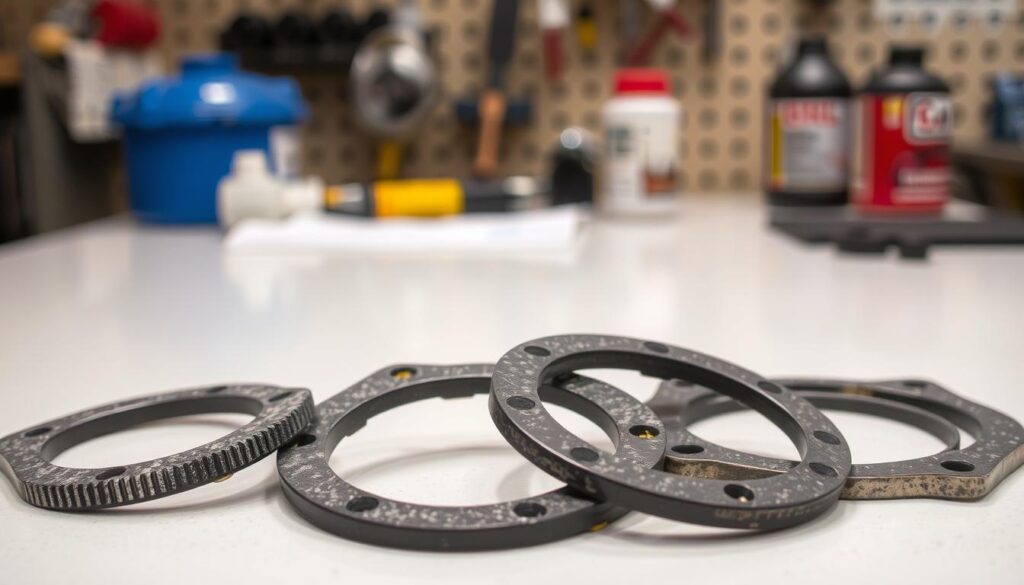
| Common Oil Leak Causes | Signs | Solutions |
|---|---|---|
| Double Filter Gaskets | Oil pooling under the vehicle | Remove old gasket, install new filter correctly |
| Bad Filter Installation | Oil spots over time | Hand tighten and turn a quarter turn with a wrench |
| Drain Plug Issues | Visible oil leak from the drain plug area | Tighten drain plug securely; replace damaged parts |
Identifying the Symptoms of Oil Leaks
It’s key to know the signs of oil leaks in your car for its well-being. Different signs can alert you to oil issues, letting you act before things get worse. Always watch your vehicle’s dashboard, especially the oil light.
Oil Warning Light
The oil warning light on your dashboard is a critical indicator. When it turns on, it usually means a big drop in oil levels, often from a leak. If you ignore this, you could harm your engine because low oil leads to not enough lubrication and overheating. Additionally, it’s crucial to address the issue immediately by checking the oil level and refilling if needed. If the oil change has been completed and the warning light persists, you may need to reset it manually. To reset Chevy Traverse oil light, refer to your vehicle’s manual for the appropriate instructions, ensuring the system accurately reflects the new oil change. Failure to reset could obscure future warnings.
Visible Oil Puddles
Seeing oil puddles under your car is a clear sign of a leak. These puddles are brown and slick, coming from leaks in parts like the oil filter or drain pan. Finding where these leaks come from helps you fix them fast and avoid more damage.
Burning Oil Smell or Smoke
Noticing a burning oil smell while driving could mean oil is leaking onto hot engine parts. This might cause smoke and signal a big problem that needs fast action. It’s important to handle these signs to stop your engine from overheating and keep your car running well.
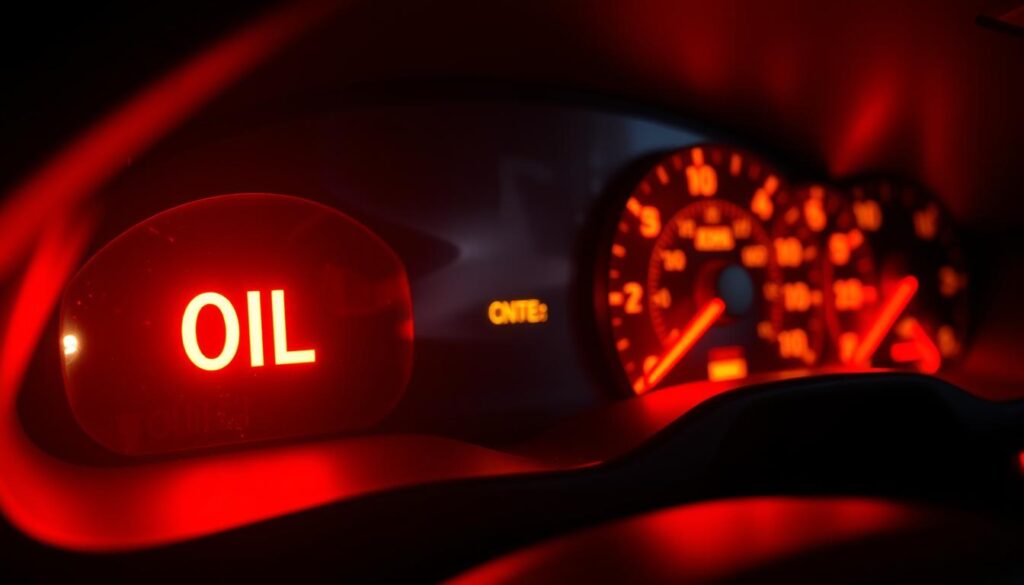
| Symptom | Description | Implications |
|---|---|---|
| Oil Warning Light | Dashboard indicator showing low oil levels. | Possible engine damage from low lubrication. |
| Visible Oil Puddles | Brown, slick spots under the vehicle. | Leaking could worsen, affecting oil pressure. |
| Burning Oil Smell | Smell of burned oil inside or outside the vehicle. | Chance of smoke and engine overheating. |
Being alert to these symptoms can prevent expensive repairs and keep your vehicle in top shape for the long run.
How to Fix Oil Leaks After an Oil Change
It’s critical to fix oil leaks quickly to keep your car running well. Addressing issues like double gaskets and drain plug problems is essential. This can prevent engine damage. Here are some tips for both professionals and do-it-yourselfers.
Fixing Double Gaskets Issue
Oil filter leaks often start with double gasket issues. A double gasket happens if the old one sticks to the engine when you change the oil filter. Here’s how to solve it:
- Drain the old oil to avoid spills.
- Make sure the new oil filter area is clean.
- Apply a bit of oil to the new gasket for a good seal.
- Put on the new filter, tightening it ¾ turn for a snug fit to avoid leaks.
Taking care of your oil pan regularly can make your car parts last longer. This reduces the need to fix double gaskets often.
Correcting Drain Plug Problems
Drain plug issues can cause a lot of oil to leak if ignored. First, see if the drain plug is tight enough. Here’s a guide to fix drain plug leaks:
- Use the right wrench to check the drain plug’s tightness.
- If it’s loose, tighten it just right to avoid breaking it.
- Look at the washer for any wear and replace it if needed.
Following these steps will help stop oil drain leaks. Regular engine checks can also find problems early. This ensures your engine stays in good shape.
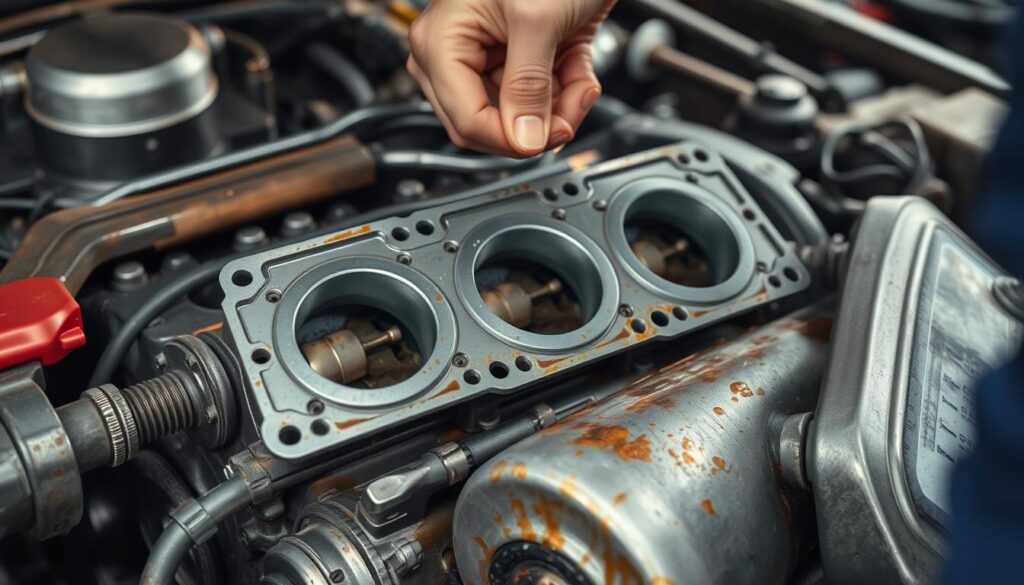
| Issue | Solution | Tips |
|---|---|---|
| Double Gaskets | Inspect and replace the oil filter, ensuring proper installation | Lubricate the gasket with oil |
| Drain Plug | Tighten the drain plug with the correct wrench | Replace washer if worn or cracked |
Preventative Measures to Avoid Oil Leaks
Regular check-ups prevent oil leaks. It’s key to have a schedule for changing your oil to keep your engine running long. Using high-mileage oil is great for cars with over 75,000 miles. It helps in protecting the engine parts.

Knowing about oil thickness is crucial; diesel vehicles need thicker oil than gas ones. Always pick the right oil and filter for your car. If you ignore this, you might face leaks.
- Inspect and replace gaskets and seals as necessary.
- Check for loose bolts and fittings to ensure they are properly tightened.
- Monitor your oil levels consistently. An oil puddle between 1 to 2 inches might indicate early seepage, so be proactive.
How you drive and where you live affects your gaskets. Coastal areas or places with big temperature swings can damage them. Checking your engine regularly helps find small leaks early. This stops them from becoming big problems. These car care tips are really helpful.
Potential Impact of Ignoring Oil Leaks
If you ignore oil leaks, your car could face big problems. Consequences of oil leaks include a risk of engine damage. Low oil levels from leaks cause more friction inside the engine. This can make your engine overheat and even stop working. Fixing or replacing the engine can cost a lot of money.
Oil leaks happen for several reasons. Faulty gaskets, seals, or ill-fitting oil caps can cause leaks. These issues lead to oil leak neglect, hurting your car’s performance. Not fixing leaks leads to a cycle of less efficient engine work and higher repair costs. It may result in less power and more pollution, which can fail emission tests.
It’s best to fix oil leaks right away. Check your car for oil spots or get a mechanic to look. Taking action early stops the situation from getting worse. Ignoring the problem can lead to bigger issues than just the leak.
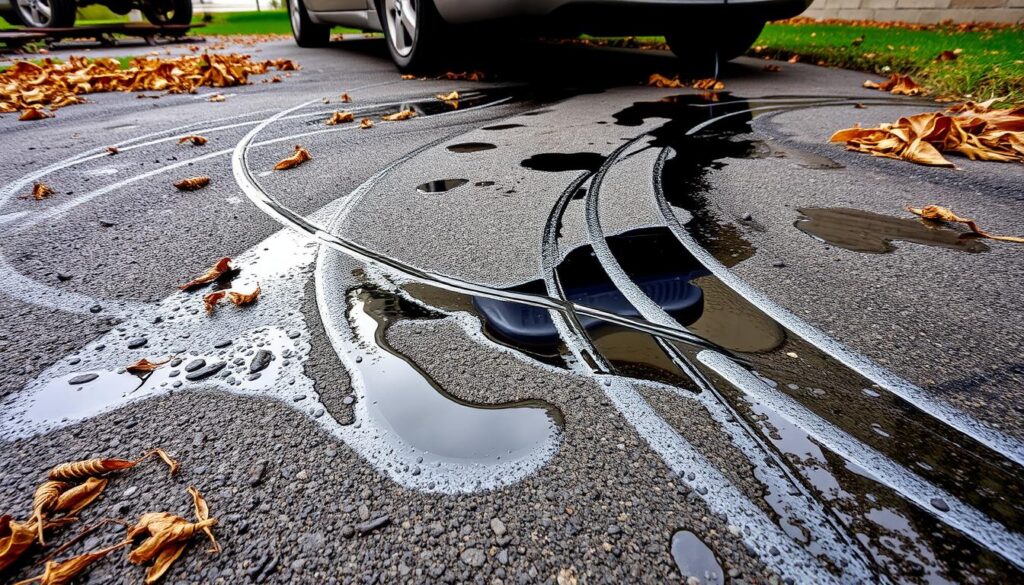
Conclusion
Understanding the causes and solutions for oil leaks is key to your vehicle’s health. These leaks can start in places like the oil filter or drain plug. By keeping up with oil changes and check-ups, you can prevent big problems.
It’s critical to fix oil leaks quickly. Ignoring them can lead to expensive repairs or damage to your engine. If your car has an oil leak, don’t drive it. This will prevent more damage.
Keep your engine running well by being attentive. This means regular oil changes, checking fluid levels, and getting help when needed. Doing these things will make your vehicle last longer and run better.
